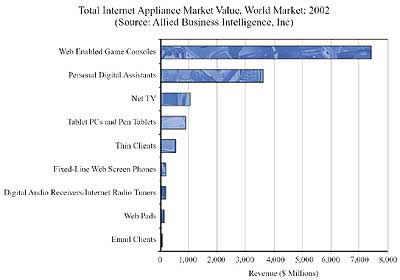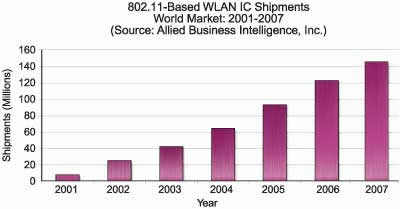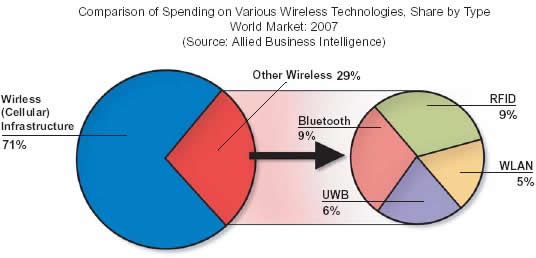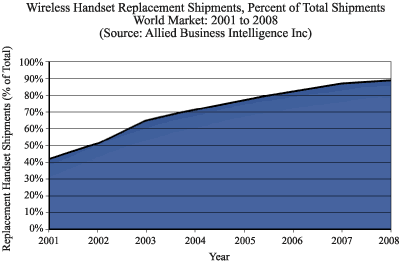 |
|
|
Tablet PCs Debut with the Potential as Next Killer App But PDAs Will Increase Pressure Internet appliances (IA) face a bumpy road even as devices mature and re-focus. New Tablet PCs have been introduced to take on the corporate market. Allied Business Intelligence (ABI) projects the IA market value to increase to $14 billion in 2002, up from $13 billion in 2001. Over the longer term, the IA market is forecast to grow to $32 billion by 2007. Many devices in the IA market suffered from misdirected marketing at the outset. As vendors try to re-position products to compliment PCs in the home rather than replace them, their acceptance and use will catch on. Microsoft’s Tablet PC re-invents penbased computing in the workplace and may be the needed boost in the arm to lagging PC sales. Wireless solutions will gain attention as broadband access becomes more widespread. Although IA devices will experience faster growth rates, they will not overtake PC shipments over the forecast period. "Microsoft's commitment to the Tablet PC will bring mobile computing to a new class of corporate users. These corridor warriors will account for revenues of nearly $10 billion by 2007" said Laraine Tunick, Analyst and report author. "However, handwriting recognition and form factor issues will need to be addressed in future releases after road testing. The Tablet PC will also have to fend off advances being made by personal digital assistants (PDA) as devices with mobile and wireless functionalities proliferate."
Driven by strong growth in the SOHO/retail market segment and broader global demand for 802.11x based wireless local area network (WLAN) solutions, shipments of chipsets are set to hit 23 to 25 million units this year, up from 7.9 million in 2001. This is considerably above initial expectations for 14-15 million chipsets, and it points towards an acceleration in catalysts driving Wi-Fi adoption. Taking into account rapid price declines of ICs, a growing confidence in new addressable markets and the immense interest in 802.11 technology Allied Business Intelligence’s (ABI) new forecasts indicate that between 2002 and 2007 Wi-Fi chipset shipments are set to grow at a CAGR of 43%. Hence by 2007 shipments will reach 147.5 million chipsets, with revenues of $1.13 billion. "There is a very elastic relationship between
pricing and demand in the wireless LAN market, and every step
down in prices brings the industry closer to unlocking new opportunities
and applications," said John Chang, ABI Senior Analyst.
"There is fierce competitive innovation in this market
and it is critical for market participants to commit significant
resources if they hope to compete successfully against the likes
of Intersil and Intel, whose Calexico dual-band 802.11a/b offering
will ship in 2003."
Slowly but Surely: Wireless Networks of All Types, including WLAN, Bluetooth, UWB and RFID will Permeate Society Wireless networks of varying types, capabilities and ranges are slowly pervading society. Advanced 2.5G and 3G cellular networks are only the beginning as other technologies, including wireless local area networks (WLAN), Bluetooth, radio frequency identification (RFID) and even ultra wideband (UWB) networks are deployed. Cumulative revenues garnered through the global adoption of these technologies, excluding cellular, will likely exceed $33 billion by 2007, according to Allied Business Intelligence (ABI). Wireless technologies, nearly ubiquitous for voice communications, will begin to penetrate new applications and platforms, including industrial management and transportation. Radio Frequency Identification (RFID), for example, is now poised to revolutionize supply chain management through its ability to remotely identify crates, boxes and even individual items through "smartlabels." ABI research indicates that these applications represent merely 1% of total RFID transponder shipments today, increasing to represent about 46% of all shipments by 2007. Even the family car will be wirelessly enabled. "By 2007, Bluetooth and WLAN nodes will be common features for the automotive platform. Initially geared towards telephony applications, Bluetooth nodes will soon serve additional functions, including remote vehicle diagnostics," according to Frank Viquez, Director of Automotive Technologies at ABI. The industry research firm expects 19% of all vehicles to become equipped with Bluetooth by 2007. Much of the information collected by these so-called
personal area networks (PAN) will still rely upon the widely
available cellular networks. "The 2.5G and 3G networks
will bridge the gap between the localized PAN and the broader
Internet. All of these wireless technologies will be codependent
upon each other," says Edward Rerisi, Director of Wireless
Research at ABI. "In a sense, these various network configurations
will feed demand for the other segments," adds Mr. Rerisi.
Smartphones Will Dominate Wireless Handset Market By 2008 A migration trend is emerging among wireless users toward feature rich devices that incorporate color screens and advanced data and messaging applications, including navigation, multimedia messaging (MMS), and instant messaging, among others. The primary catalysts of this trend are a combination of factors. For one, wireless handset penetration continues to grow, moving the market from one characterized by initial penetration to that of replacement with next generation devices. Secondly, wireless operators are under increased pressure to drive higher average revenue per subscriber (ARPU) and are doing so by adding data services and "infotainment" content available to newer technology handsets. "With handset makers and wireless operators developing new devices and compelling services, the replacement cycle will shorten, accelerating growth in the handset," states Kenil Vora, an analyst with ABI. "Key to maintaining this growth is the successful deployment - and timing - of feature-rich devices and related services." Inside The Numbers
|
|||||||
© PDA cortex. All
Rights Reserved
IT's Cutting Edge




